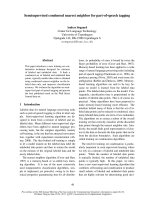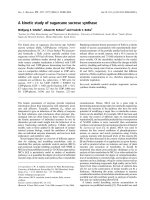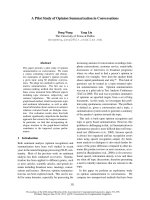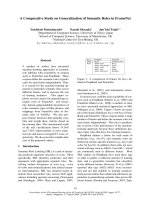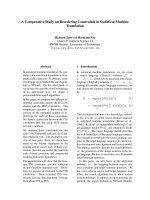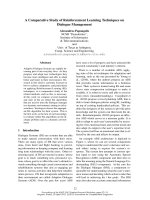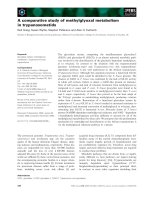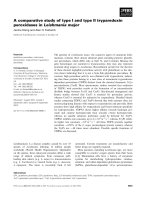Báo cáo khoa học: " A new resorbable device for ligation of blood vessels - A pilot study" pps
Bạn đang xem bản rút gọn của tài liệu. Xem và tải ngay bản đầy đủ của tài liệu tại đây (2.18 MB, 7 trang )
RESEA R C H Open Access
A new resorbable device for ligation of blood
vessels - A pilot study
Odd V Höglund
1*
, Ragnvi Hagman
1
, Kerstin Olsson
2
, Jonas Mindemark
3
, Niklas Borg
4
and Anne-Sofie Lagerstedt
1
Abstract
Background: During surgery, controlled haemostasis to prevent blood loss is vital for a successful outcome. It can
be difficult to ligate vessels located deep in the abdomen. A device that is easy to use and enables secure
ligatures could be beneficial. Cable ties made of nylon have been used for ligation but the non-resorbable material
caused tissue reactions. The objective of this study was to use a resorbable material to construct a device with a
self-locking mechanism and to test its mechanical strength and ligation efficiency.
Methods: The device was manufactured by injection moulding of polydioxanone, a resorbable polymer used for
suture materials. Polydioxanone with inherent viscosities of 1.9 dL/g and 1.3 dL/g were tested. The device
consisted of a perforated flexible band which could be pulled through a case with a locking mechanism. After a
first version of the device had been tested, some improvements were made. The locking case was downsized,
corners were rounded off, the band was made thicker and the mould was redesigned to produce longer devices.
Tensile tests were performed with the second version.
The first version of the device was used to ligate the ovarian pedicle in a euthanized dog and to test echogenicity
of the device with ultrasound. Compression of vessels of the ovarian pedicle was examined by histology. Both
versions of the device were tested for haemostasis of and tissue grip on renal arteries in six anaesthetised pigs.
Results: The tensile strength of the flexible band of the devices with inherent viscosity of 1.9 dL/g was 50.1 ± 5.5
N (range 35.2-62.9 N, n = 11) and the devices with inherent viscosity of 1.3 dL/g had a tensile strength of 39.8 ±
8.1 N (range 18.6-54.2 N, n = 11). Injection moulding of the polymer with lower inherent viscosity resulted in a
longer flow distance.
Both versions of the device had an effective tissue grip and compl ete haemostasis of renal arteries was verified.
The device attached to the ovarian pedicle could be seen with ultrasound, and vessel compres sion and occlusion
were verified by histology.
Conclusions: Tests of functionality of the device showed complete haemostasis and good tissue grip. Devices with
a band of sufficient length were easily applied and tightened in tissue.
Background
Bleeding associated with surgery i s a potentially serious
complication. Haemostasis to prevent blood los s is com-
monly achieved by tying a surgical thread around the
bloo d vessel. Vessels localized deep in t he abdomen can
be difficult to ligate [1]. A device that enables secure
ligatures that are easily applied could be beneficial.
The use of non-resorbable nylon cable ties for hae-
mostasis in soft tissue surgery has been described [2-8].
However, non-resorbable materials used for ligation
purposes an d left permanently i n tissue, can cause com-
plications such as fistulas and granulomas [9-11]. The
advantages of cable tie s for ligation purposes were ease
of application, quick ligation procedures and good
“knot” se curity [6-8]. If a device, based on the construc-
tion of a self-locking loop, could b e made of a resorb-
able material it could minimize the risk of adverse tissue
reactions but potentially maintain the advantages experi-
enced with traditional cable ties.
The aim of this study was to develop a device of a
resorbable material, which enables reliable and easy liga-
tion of blood vessels.
* Correspondence:
1
Department of Clinical Sciences, Swedish University of Agricultural Sciences,
Box 7054, SE-750 07 Uppsala, Sweden
Full list of author information is available at the end of the article
Höglund et al. Acta Veterinaria Scandinavica 2011, 53:47
/>© 2011 Höglund et al; licensee BioMed Central Ltd. This is an Open Access article distributed under the terms of the Creat ive
Commons Attribution License ( which permits unrestricted use, distribution, and
reproduction in any me dium, pr ovided the original work is properly cited.
Methods
Design of the device
To construct the device computer-aided design (Solid-
works, Dassault Systèmes SolidWorks Corporation, Con-
cord, USA) was used. The dimensions were selected
according to the desired strength, possible flow distance
during injection moulding and ability of the device to
fully close. The device consisted of a flexible band, in
part perforated, and a case with a locking mechanism
where the band could be introduced and pulled through.
Details for tissue engaging properties were added to the
locking case and the band surface (Figure 1). A protru-
sion at the connection between locking case and band
formed a cog merging with the first hole in the band
when the band was fully pulled through. The tissue-
engaging ridges at the side of the locking case aligned
towards the band surface and connected with tissue
caught in the loop.
Design of moulds for injection moulding
The device was manufactured in purpose-built steel
moulds (Mecdon, Laxå, Sweden). During development a
redesigned secon d version’s mould was m ade to improve
the device. The second version of device had a downsized
locking case, thinner walls and rounded-off corners. Con-
sequentl y it contained less material than the first version
(Figure 2). The inlet for the polymer into the second ver-
sion’s mould was adjusted and thethicknessoftheflex-
ible band increased from 0.55 mm to 0.65 mm which
created bands of greater length and strength. Controlled
heating was used in the second version’ smouldfor
improvement of flow distance during injection moulding.
Injection moulding of polydioxanone
Polydioxanone (Resomer
®
X, Boehringer Ingelheim
Pharma GmbH, D-55216 Ingelheim, Germany) was cho-
sen for the material of the device, a synthetic resorbable
polymer which is widely used for suture materials and
implants since many years. It is flexible and elastic and
its induction of inflammatory reactions is minimal. It is
degraded through hydrolysis and may be completely
resorbed within 6-12 months [12,13].
The polymer was heated above melting temperature
and injected into the mould using an in-house built
Figure 1 Design of device. The resorbable device comprised an elongated, flexible band (A) in part perforated (B) that formed a ladder
structure and was connected to a locking case (C) that had a channel (D) dimensioned for reception of the band (A). A locking device (E) was
configured to interlock the perforated band (B) when the band (A) was pulled through the channel (D) and a reverse-motion brake was formed.
A protrusion (F) and a matching receiver (G) were arranged at the channel entrance and in the band-locking case interface. The receiver (G) was
dimensioned for inclusion of the protrusion (F) when the band (A) was close to fully pushed into the locking case (C). Tissue-engaging ridges
(H) were arranged on the side of the locking case of the device and on the front side (I) of the band.
Höglund et al. Acta Veterinaria Scandinavica 2011, 53:47
/>Page 2 of 7
injection moulding machine. High pressure was main-
tained after injection and crystallization was allowed to
occur for about one minute before the mould was
opened. Polydioxanone of inherent viscosity of 1.9 dL/g
was used for injectio n moulding in the first version’s
mould. Two batches of polydioxanone with inherent
viscosities of 1.9 and 1.3 dL/g respectively were t ested
for injection moulding in the second version’s mould.
Tensile testing
The tensile strength of the flexible band was measured
using a 5544 Single Column Testing System (Instron,
USA). Samples were prepared by cutting away the lock-
ing case of t he device and the solid part of the flexible
band, leaving approximately 4 cm of the perforated
band. The samples were clamped 1 cm from each end
and pulled to break at a rate of deformation of 40 mm/
min. The tensile strength was determined as the maxi-
mum failure load. Eleven samples manufactured from
each of the polymer batches of polydioxanone were
tested. All tested devices were of the second version.
The level of stat istical significance was defined as p <
0.05 (Student’s t-test, equal variances not assumed).
Animals
One dog weighing 20 kg, which wa s euthanized prior to
the test due to reasons not associated with this study,
and six pigs weighing 25-28 kg, which were anaesthe-
tised for other reasons at Uppsala University Hospital,
Sweden, were us ed in the study. The Uppsala Animal
Figure 2 The two versions of the resorbable device used in the study. Figure 2A. The first version of the device had a larger locking case
and shorter band. Polydioxanone with inherent viscosity of 1.9 dL/g was used. Figure 2 B. The second version of the device had a smaller
locking case and longer band. Polydioxanone with inherent viscosity of 1.3 dL/g resulted in a longer flow distance.
Höglund et al. Acta Veterinaria Scandinavica 2011, 53:47
/>Page 3 of 7
Ethics Committee, Sweden, approved this additional test
(permission number C172/8).
Test of the devices in tissue
Ovarian pedicle, imaging and histology
An incision was made from approximately 2 cm cranial
of the umbilicus along the midline of the abdomen in
the dog. The linea alba was incised, the abdomen
opened and the uterine horns and ovaries were loca-
lized. A hole was made in the broad ligament close to
the left ovary. A loop was formed around the ovarian
pedicle and the band was pushed into the locking
mechanism (first version of the device). The loop was
tightened, compressing the tissue inside the loop. The
surplus b and extending beyond the channel exit in the
locking case was cut off.
The echogenicity of the device was examined with
ultrasound (Sequoia 512, Acuson, Siemens AG Medi-
cal Solutions, Germany) with an 8.0 MHz linear
probe. The probe was placed on the abdomen after
application of ultrasound gel on the skin. After the
investigation the device with adjacent tissue was
removed and embedded in resin (Historesin, Leica
Microsystems Nussloch GmbH, Germany). After
dehydration in increasing concentrations of ethanol,
followed by increasing concentrations of water-soluble
resin, the sample was embedded in 100% resin. Sec-
tions were cut using a microtome (Leica RM 2165,
Leica Instruments G mbH, Germany) wit h glass knives
as close as p ossible to t he device. The samples were
mounted on glass and stained with hematoxylin and
eosin (HE).
Test of haemostasis and tissue grip of renal arteries
in six pigs
The abdomen was opened midway along the linea alba
and both renal arteries were free-dissected in two (first
version) and four pigs (second version), respectively. A
loop was formed around the artery with the device and
the loop was tightened causing compression of the ves-
sel. When the band was fully pulled through the locking
case of the device, the artery was cut between the kid-
ney and the device about 0.5 cm from the device. The
renal artery with the attached device was inspected for
haemostasis for about 5 minutes. The ability of the
device to withstand a ligature slip-off was tested by
applying a force of 10 N using a dynamometer attached
to the device.
Arterial blood pressure was registered by invasive con-
tinuous measurements in the femoral artery of the pigs
and was recorded once a minute (SC 9000XL, Siemens
Medical Solutions, USA). The least square means of sys-
tolic and diastolic blood pressures during ligation were
calculated.
Results
Injection moulding of polydioxanone
The mould for version one resulted in short devices
whereas the modified design of mould for version two
improved manufacturing results. The polymer with an
inherent viscosity of 1.9 dL/g resulted in a shorter flow
distance in the moulds and made the flexible band too
short for optimal handling during surgery. The polymer
with an inherent viscosity of 1.3 dL/g resulted in a
longer flow distance, 10 cm, and the second version’s
mould was filled. A higher temperature of the melted
polymer and mould facilitated flow dist ance in the
mould but a higher temperature o f the mould increased
the time needed for crystallization. At least one minute
was necessary for crystallisation of the polymer to
occur. The material of the device expanded if sufficient
crystallization had not occurred when the mould was
opened, which caused constriction of the channel
through the locking case.
Tensile testing
The tensile strength of the device was assessed by mea-
surement of the m aximum failure loa d. The mean ten-
sile strength (mean ± 95% confidence limits) for devices
manufactured from the 1.9 dL/g batch was 50.1 ± 5.5 N
(sample r ange 35.2-62.9 N). For devices manufactured
from the 1.3 dL/g batch, the mean tensile strength was
39.8 ± 9.1 N (sample range 18.6-54.2 N). The difference
between these two measurement series was statistically
significant (p = 0.031). Typical mechanical responses to
this test can be seen in Figure 3.
Tests of first and second version of the device in tissue
The flexible band of the first version of device (1.9 dL/g)
was too short for easy applicat ion around the tissue and
therefore extended with a thread whereas the second
version of the device, made from the lower inherent
Figure 3 Tensile testing. Typical load versus strain curves for the
devices at a rate of deformation of 40 mm/min.
Höglund et al. Acta Veterinaria Scandinavica 2011, 53:47
/>Page 4 of 7
viscosity material (1.3 d L/g), was sufficiently long. The
loop of the device, however, was easily tightened with
one hand. When the ovarian pedicle was ligated one
handwasusedtoholdtheovaryandsecureaproper
distance between the loop of the device and t he ovary.
The other hand tightened the loop of the device and the
tis sue inside the loop was compressed (Figure 4). Ultra-
sonographic examination after application of the device
in the dog showed that the device was hyperechoic and
caused an obvious acoustic s hadowing. The histological
examination of the compressed tissue of the ovarian
pedicle showed occlusion of vessels (Figure 4).
Complete haemostasis of all twelve arteries was
obtained (Figure 5) a nd verified for five minutes. The
devices were secu rely locked into the tissue, i.e. no slid-
ing along the vessels was observed. The systolic and dia-
stolic blood pressures during ligation were 104/64
mmHg.
Discussion
The production of the resorb able device was successful
and the tests of functionality in animal tissues showed
that an effective tissue grip and complete haemostasis
were achieved.
The use of polydioxanone of higher inherent viscosity
(1.9 dL/g) increased the tensile strength of the device
but was a limitation in the manufacturing process due
to shorter flow distance. The flow distance can be
increased with higher temperature of the mould, but
then the time needed for crystallization may have to be
shortened by cooling the mould. The optimal process
temperature during injection moulding is dependent of
desi red flow distance, diameter of the mould’s channels,
inherent viscosity of the polymer, its melting point and
injection pressure. A higher temperature during the
manufacturing process and lower inher ent viscosity (1.3
dL/g) facilitates flow but temperature has to be balanced
against detrimental change of properties of the polymer
[14]. The inherent viscosity of the polymer also affected
mechanical characteristics of the device, as would be
expected by the difference in molecular weight. The
results of the tensile test are similar to other studies of
suture material (polydioxanone 3-0) at time zero [15,16]
but comparisons should be done cautiously as the meth-
ods used are not identical.
Both versions of the device were tested on free-dis-
sected renal arteries. Ligatures on the renal artery in
connection with nephrectomy must be strong enough to
prevent bleeding due to the high blood pressure in these
vessels. Two ligatures [17] or two clips on the renal
artery [18,19] are therefore regularly applied for security
reasons. The device, however, has a built-in double
security and yields two ligations similar to a double liga-
ture. The renal arteries in the pigs, pressed towards the
Figure 4 Tissue test. 4a. Ligation of the ovarian pedicle in a dog cadaver using the first version of the device. 4b. Histologic image of the
compressed artery in the ovarian pedicle adjacent to the device.
Höglund et al. Acta Veterinaria Scandinavica 2011, 53:47
/>Page 5 of 7
protrusion and the ridges, were squeezed into a zigzag
pattern which created haemostas is. A double ligation is
achieved by pressing the artery against the two ridges,
oneoneachsideofthelockingcase.Ifonesideofthe
bandbreakstheflexiblebandcannotbereversed
through the locking case. The construction also prevents
the device to slide off the tissue. The renal arteries of
the pigs were only observed for a short time, but com-
plete haemostasis was obtained. Sufficient length of the
device is important for ease of application in tissue and
longer devices were successfully manufactured with the
mould o f the second version of the device and a lower
inherent viscosity. A smooth and easy passage of the
band through the locking case with a trustworthy
mechanical performance of the lo cking mechanism of
the device is essential for safety.
In the dog, the device effectively compressed the ves-
sels together with the surrounding fatty tissue in the
ovarian pedicle as verified by histology. The size of the
self-locking loop of the device suggests that it may be
used for ovari an pedicles regardless of breed size. The
device could be seen on ultrasound imaging. The poly-
mermayinthefuturebeblendedwitharadiopaque
substance to facilitate x-ray imaging [20]. There were
some study limitations. The degradation effect on the
polymer during the manufacturing process was not
investigated and the tensile test was restricted to the
perfor ated flexible band of a limi ted number of devices.
As tests under hydrolytic conditi ons over time were not
performed, conclusions are limited to initial strength.
Conclusions
A novel inje ction moulded device made of the resorb-
able polymer polydioxanone was constructed. T ests of
functionality of the devic e showed complete haemostasis
and good tissue grip. Devices with a band of suffici ent
length were easily applied and tightened in tissue.
Acknowledgements
The authors thank Agneta Ronéus and Göran Hedenstierna at the Animal
Laboratory at Clinical Physiology, Department of Medical Sciences, Uppsala
University, Uppsala, Sweden for invaluable assistance and access to the
laboratory. We also thank Lena Holm at the Department of Anatomy,
Physiology and Biochemistry, SLU, Uppsala, Sweden for tissue preparation
enabling histologic evaluation. This project was supported by S Johansson
foundation, A Personnes foundation and Almi Företagspartner Uppsala AB,
Sweden.
Author details
1
Department of Clinical Sciences, Swedish University of Agricultural Sciences,
Box 7054, SE-750 07 Uppsala, Sweden.
2
Department of Anatomy, Physiology
and Biochemistry, Swedish University of Agricultural Sciences, Box 7011, SE-
750 07 Uppsala, Sweden.
3
Department of Materials Chemistry, Uppsala
University, Box 538, SE-751 21 Uppsala, Sweden.
4
Radi Medical Systems,
Palmbladsgatan 10, SE-754 50 Uppsala, Sweden.
Authors’ contributions
OVH conceived the idea of the device and its design, participated in
injection moulding, the design of the study and drafted the manuscript. JM
performed tensile tests, statistical analysis and helped to draft the
manuscript. NB advised and performed injection moulding. RH, KO and ASL
Figure 5 Haemostasis and tissue grip of renal artery. The renal artery of an anaesthetised pig ligated with the first version of the device.
Höglund et al. Acta Veterinaria Scandinavica 2011, 53:47
/>Page 6 of 7
participated in the design of the study, its coordination and helped to draft
the manuscript. All authors read and approved the final manuscript.
Competing interests
The first author is owner of granted patent of the design of the device. The
other authors declare that they have no competing interests.
Received: 23 March 2011 Accepted: 8 July 2011 Published: 8 July 2011
References
1. Berzon JL: Complications of elective ovariohysterectomies in the dog
and cat at a teaching institution: clinical review of 853 cases. Vet Surg
1979, 8:89-91.
2. McDougall EM, Clayman RV, Chandhoke PS, Kerbl K, Stone AM, Wick MR,
Hicks M, Figenshau RS: Laparoscopic partial nephrectomy in the pig
model. J Urol 1993, 149:1633-6.
3. Cadeddu JA, Corwin TS, Traxer O, Collick C, Saboorian HH, Pearle MS:
Hemostatic laparoscopic partial nephrectomy: cable-tie compression.
Urology 2001, 57:562-6.
4. Cokelaere SM, Martens AM, Wiemer P: Laparoscopic ovariectomy in mares
using a polyamide tie-rap. Vet Surg 2005, 34:651-6.
5. Adams RJ, Narayan O: Partial splenic resection using nylon cable tie
ligatures in rhesus monkeys. Lab Anim Sci 1993, 43:267-9.
6. Carpenter R: Nylon bands used as ligatures and fixation devices in small
animal surgery. Proc 40th Ann Meet Am Anim Hosp Assoc 1973, 718-721.
7. Zagraniski MJ: Splenectomy using nylon cable tie bands. Feline Practice
1979, 9:33-35.
8. Zagraniski MJ: Ovariohysterectomy in the pregnant cat utilizing a nylon
cable tie band. Feline Practice 1980, 10:41-44.
9. Werner RE, Straughan AJ, Vezin D: Nylon cable band reactions in
ovariohysterectomized bitches. J Am Vet Med Assoc 1992, 200:64-66.
10. Fossum T: Small Animal Surgery. Mosby Elsevier;, 3 2007, 61.
11. Spackman C, Caywood D, Johnston G, Feeney D: Granulomas of the
uterine and ovarian stumps: A case report. J Am Anim Hosp Assoc 1984,
20:449-453.
12. Middleton JC, Tipton AJ: Synthetic biodegradable polymers as medical
devices. Medical Plastics and Biomaterials Magazine 1998.
13. Molea G, Schonauer F, Bifulco G, D’Angelo D: Comparative study on
biocompatibility and absorption times of three absorbable
monofilament suture materials (Polydioxanone, Poliglecaprone 25,
Glycomer 631). Br J Plast Surg 2000, 53:137-41.
14. von Oepen R, Michaeli W: Injection moulding of biodegradable implants.
Clinical Materials 1992, 10:21-8.
15. Greenberg CB, Davidson EB, Bellmer DD, Morton RJ, Payton ME: Evaluation
of the tensile strengths of four monofilament absorbable suture
materials after immersion in canine urine with or without bacteria. Am J
Vet Res 2004, 65:847-53.
16. Nichols S, Anderson DE: Breaking strength and elasticity of synthetic
absorbable suture materials incubated in phosphate-buffered saline
solution, milk, and milk contaminated with Streptococcus agalactiae. Am
J Vet Res 2007, 68:441-5.
17. Rawlings C, Bjorling D, Christie B: Kidneys. In Textbook of small animal
surgery. Volume 2 3 edition. Edited by: Slatter D. Philadelpha: Saunders;
2003:1608-1609.
18. Modi P, Rizvi SJ, Gupta R: Use of Hem-o-lok clips for vascular control
during retroperitoneoscopic nephrectomy in children. J Endourol 2009,
23.
19. Ponsky L, Cherullo E, Moinzadeh A, Desai M, Kaouk J, Haber GP, Chen D,
Ng C, Fuchs G, Singh D, Finelli A, Frank I, Matin S: The Hem-o-lok clip is
safe for laparoscopic nephrectomy: a multi-institutional review. Urology
2008, 71:593-6.
20. Mottu F, Rüfenacht DA, Doelker E: Radiopaque polymeric materials for
medical applications: Current aspects of biomaterial research. Invest
Radiol 1999, 34:323-335.
doi:10.1186/1751-0147-53-47
Cite this article as: Höglund et al.: A new resorbable device for ligation of
blood vessels - A pilot study. Acta Veterinaria Scandinavica 2011 53:47.
Submit your next manuscript to BioMed Central
and take full advantage of:
• Convenient online submission
• Thorough peer review
• No space constraints or color figure charges
• Immediate publication on acceptance
• Inclusion in PubMed, CAS, Scopus and Google Scholar
• Research which is freely available for redistribution
Submit your manuscript at
www.biomedcentral.com/submit
Höglund et al. Acta Veterinaria Scandinavica 2011, 53:47
/>Page 7 of 7
